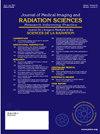Differentiation of Benign and Malignant Lymph Nodes using Ultrasound-based Radiomics and Machine Learning
IF 1.3
Q3 RADIOLOGY, NUCLEAR MEDICINE & MEDICAL IMAGING
Journal of Medical Imaging and Radiation Sciences
Pub Date : 2024-10-01
DOI:10.1016/j.jmir.2024.101544
引用次数: 0
Abstract
Background
The evaluation of lymph node characteristics is crucial for tumor staging and patient prognosis assessment, but cytological and histopathological examinations of lymph nodes are invasive and costly. This study aims to develop machine learning models for differentiating benign and malignant lymph nodes based on radiomics features of grayscale ultrasound images and patients‘ clinical characteristics.
Methods
Between 2021 and 2023, a total of 285 ultrasound images of lymph nodes were collected from 88 patients. The diagnosis of lymph nodes was confirmed by pathological examination. The image feature reduction process was done by student's t-test, Pearson correlation analysis, and Random Forest feature importance selection. Six well-established machine learning models, including Support Vector Machines (SVM), Stochastic Gradient Descent (SGD), k-nearest Neighbors (KNN), Random Forest, XGBoost, and LightGBM, were developed using a combination of patient's clinical features and radiomics features of ultrasound images. The cases were randomly divided into training and test sets in an 8:2 ratio, and the area under the receiver operating characteristic curve (AUC) was adopted to evaluate model performance.
Results
There were 135 malignant and 150 benign cases in this study, including neck and axillary lymph nodes. A total of 11 radiomics features and one clinical feature were generated after the selection process, and they were used to build the final model. The AUC values of the SGD, SVM, KNN, Random Forest, XGBoost, and LightGBM in differentiating benign and malignant lymph nodes were 0.817, 0.765, 0.746, 0.816, 0.766, and 0.747, respectively.
Conclusion
By utilizing machine learning models, particularly the SGD and Random Forest, it is possible for radiomics features from ultrasound images to effectively classify benign and malignant lymph nodes, thereby improving diagnostic efficiency.
利用超声放射组学和机器学习区分良性和恶性淋巴结
背景淋巴结特征评估对肿瘤分期和患者预后评估至关重要,但淋巴结细胞学和组织病理学检查具有侵入性且成本高昂。本研究旨在根据灰度超声图像的放射组学特征和患者的临床特征,开发用于区分良性和恶性淋巴结的机器学习模型。淋巴结的诊断由病理检查确认。通过学生 t 检验、皮尔逊相关分析和随机森林特征重要性选择对图像特征进行还原。结合患者的临床特征和超声图像的放射组学特征,建立了六种成熟的机器学习模型,包括支持向量机(SVM)、随机梯度下降(SGD)、k-近邻(KNN)、随机森林(Random Forest)、XGBoost 和 LightGBM。将病例按 8:2 的比例随机分为训练集和测试集,并采用接收者工作特征曲线下面积(AUC)来评估模型性能。经过筛选后,共产生了 11 个放射组学特征和 1 个临床特征,并将它们用于建立最终模型。SGD、SVM、KNN、Random Forest、XGBoost 和 LightGBM 在区分良性和恶性淋巴结方面的 AUC 值分别为 0.817、0.765、0.746、0.816、0.766 和 0.747。
本文章由计算机程序翻译,如有差异,请以英文原文为准。
求助全文
约1分钟内获得全文
求助全文
来源期刊

Journal of Medical Imaging and Radiation Sciences
RADIOLOGY, NUCLEAR MEDICINE & MEDICAL IMAGING-
CiteScore
2.30
自引率
11.10%
发文量
231
审稿时长
53 days
期刊介绍:
Journal of Medical Imaging and Radiation Sciences is the official peer-reviewed journal of the Canadian Association of Medical Radiation Technologists. This journal is published four times a year and is circulated to approximately 11,000 medical radiation technologists, libraries and radiology departments throughout Canada, the United States and overseas. The Journal publishes articles on recent research, new technology and techniques, professional practices, technologists viewpoints as well as relevant book reviews.
 求助内容:
求助内容: 应助结果提醒方式:
应助结果提醒方式:


